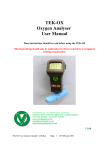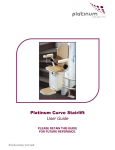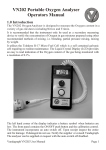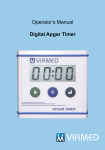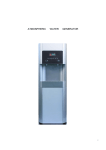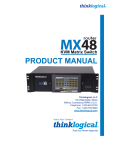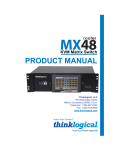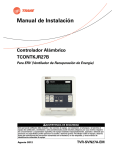Download TEK-OX Oxygen Analyser User Manual
Transcript
TEK-OX Oxygen Analyser User Manual These instructions should be read before using the TEK-OX Mixed gas diving should only be undertaken by divers trained by a recognised training organisation. Vandagraph Ltd 15, Station Road, Crosshills, Keighley, West Yorkshire, BD20 7DT. United Kingdom. Tel 01535 635900 Fax 01535 635582 www.vandagraph.co.uk [email protected] [email protected] TEK Ox manual 1.06.doc 23/06/09 1 Thank you for purchasing the TEK-OX If you have any comments or queries regarding any Vandagraph product, including the TEK-OX and sensors, please contact us either by telephone, Fax, email or by visiting our website. Warranty Vandagraph warranty ensures that goods are free from defects of manufacture for a period of one year from the date of shipment from Vandagraph. Liability shall be limited solely to the replacement and repair of the goods and shall not include shipping costs or other incidental costs. This warranty is null and void if any items are subjected to misuse, negligence, accident, or repairs other than those performed by Vandagraph or a Vandagraph authorised service centre. Cables and transducers are not included. Although every attempt has been made to ensure that the information contained in this document is correct, Vandagraph Ltd. accept no liability for errors or the misrepresentation of this material. This analyser should only be used by trained and certified Nitrox divers. TEK Ox manual 1.06.doc 23/06/09 2 Contents 1 2 3 4 5 6 7 8 9 10 11 12 13 14 15 16 17 18 19 20 21 22 23 24 25 26 27 28 29 30 21 32 33 33 Section Front page Register product Warranty Contents Introduction Setting up the TEK-OX Battery installation or replacement Sensor installation or replacement Flow divertor Calibration in air Effects of altitude Effects of humidity 100% Oxygen Calibration Measurement of oxygen using a DINKIT Measurement of oxygen using a Quick-Ox Other methods of measurement Sensor failure Instrument failure Storage of sensors Pressure Temperature Humidity Water & moisture Discrepancy between readings and expected values Do's & Do Not's Material Safety Data Sheet (MSDS) Potential for fire and explosion Emergency and first aid procedures Handling information Protective measures Disposal General care of the TEX-OX Care of the sensor Sensor life Accuracy of the TEK-OX Trouble shooting Parts & Accessories Specification Page 1 2 2 3 3-4 5 5 5 6 6 6 7 7 8 9 9 9 9 10 10 10 11 11 11 11 12 13 13 13 13 14 14 14 15 15 15 16 17 1.0 Introduction The TEK-OX Diving Oxygen Analyser has been designed to measure the Oxygen content in a variety of gas mixtures including Nitrox and Trimix incorporating the latest in state of the art technology. It is recommended that the instrument only be used as a secondary measuring device to verify the concentration of Oxygen in gas mixtures prepared using recommended methods of mixing, i.e. partial pressure blending, molecular weight, molecular sieve and continuous blending. The TEK-OX utilizes the Vandagraph R-17VAN Micro Fuel Cell which is a self contained galvanic cell requiring no routine maintenance. The Liquid Crystal Display (LCD) provides TEK Ox manual 1.06.doc 23/06/09 3 an easy to read indication of the Oxygen content of the gas being monitored with a resolution of 0.1%. There only two controls, both can be operated with either hand. On/Off switch Calibration control The words LOW BATT appear when the batteries need replacing After approx 5 minutes the unit will switch off. However the analyser can be supplied on request with the auto switch-off disabled. Instruments with Auto switch-off disabled will have a Green On/Off button For those who would prefer a cable mounted sensor we can offer an extension cable that fits into the TekOx and allows the sensor to be connected externally onto the opposite end of the cable. Please note the TekOx extension cable, part number 9520001 is only manufactured upon request.. TEK Ox manual 1.06.doc 23/06/09 4 2. Setting Up the TEK-OX Oxygen Analyser Upon receipt, inspect the package and ensure you have the following items: Packaging may change from that shown. TEK-OX Analyser Batteries MN1500 (may already be installed.) Sensor R-17VAN (may already be installed.) Quick-start guide Carrying case. Quick-Ox or DINKIT Check the entire unit for damage. If damaged do not use, Notify the supplier or consult Vandagraph Ltd. 3. Battery & Sensor Installation or Replacement Remove the three screws on the base of the analyser and remove the compartment cover. It is gasket sealed so after a period of time it may need firm pressure to remove. Loosen the seal by moving the base from side to side. Do not lever off with a tool. Damage to the seal may result. Two AA 1.5 volt Alkaline Batteries Type MN1500, LRG 1.5 or similar must be installed in the TEK-OX the correct way to enable it to operate. Slide in the batteries in the correct way +ve to +ve -ve to -ve. Follow Label directions. Batteries must be replaced as soon as the battery symbol appears in the LCD window. Accuracy of the TEK-OX can not be guaranteed whilst the battery Lo symbol is visible. 4. Sensor Installation or replacement An R-17VAN Sensor must be installed before the TEK-OX will operate. Remove the sensor from its protective bag and visually inspect the sensor for damage or electrolyte leakage. Allow the sensor a few minutes to stabilize after installation. TEK Ox manual 1.06.doc 23/06/09 5 Rotate the sensor in the enclosure . Switch on. The sensor should settle in a few minutes, however at least 1 hour should be allowed for greatest accuracy. Never use a defective or suspect sensor. The R-17VAN sensor contains an electrolyte which is caustic. Do not let the electrolyte come into contact with skin, eyes or mouth. If it does, flush the affected area with fresh water. See section (24) on First Aid Do not attempt to open or repair the sensor. Leaking or exhausted sensors should be disposed of in accordance with local regulations which is usually similar to the disposal of batteries. Consult the Material Safety Data Sheet. Section (22) . Vandagraph offer a “Return to Vandagraph for correct disposal” service which is free when you purchase a new sensor, (extended to all types of Galvanic sensor) visit www.Vandagraph.co.uk for further informationl Before replacing the screws ensure the gasket seal is free of dirt and dust and not jammed in between the enclosure and cover. 5. The Flow divertor The Flow divertor is designed specifically to be used in conjunction with a Tee Piece or the Quick-Ox gas sampling kit. Flowing gas diverted onto the sensor face decreases the sensor response time. Failure to remove the divertor and Tee when measuring static gas will severely increase the time the sensor takes to respond and can cause substantial inaccuracies. In a stationary gas the Flow divertor traps the residual oxygen rich gas in the area just above the sensor membrane and severely slows down the ingress of fresh air into the sensor. A sensor left in air with the Flow divertor in situ can take several minutes to return to 20.9% when removed from an Oxygen enriched gas. Calibration will be inaccurate during this period. 6. Calibration in Air Should be carried out at least every 8 hours and checked between measurements Routinely calibration in air 20.9% is suitable for mixtures less than 50% Oxygen Switch on the TEK-OX Analyser Remove the Tee Piece but leave the Flow divertor on. Move the analyser through the air slowly. Adjust the Calibration control until the LCD reads 20.9% at sea level. NB Altitude, ambient pressure and humidity can all effect the accuracy of gas measurement. Sensors deteriorate very slowly and near the end of their useful life may show a drift downwards or upwards soon after calibration. • Sensors should be checked periodically with 100% Oxygen . • If analysing Nitrox below 50% an air calibration is usually sufficient. • If Analysing mixtures above 50% (e.g. decompression gases) always calibrate to 100% oxygen 7. Effects of Altitude At very high altitudes some sensors (with low outputs) may not calibrate up to the level required. At Altitude total pressure, ambient and altitude must be taken into consideration . For further information view Vandagraph website www.vandagraph.co.uk TEK Ox manual 1.06.doc 23/06/09 6 N.B. The TEK-OX measures partial pressure so will be affected by altitude and re-compression chambers. This table is a rule of thumb guide to the effect of pressure on Oxygen measurement Feet -1000 0 1000 2000 3000 4000 5000 6000 8000 10,000 12,000 Metres -305 0 305 610 915 1220 1220 1830 2440 3050 3660 Pressure mb 1.03 1 0.97 0.94 0.92 0,89 0.89 0.84 0.79 0.74 0.69 Calibrate 21.5 20.9 20.2 19.4 18.7 18.1 17.4 16.8 15.5 14.4 13.3 Values are for indication only. For greater accuracy, ambient pressure and correct altitude should be known. 8. Effects of Humidity Although not substantial, humidity can effect the maximum accuracy that can be obtained. This accounts for the difference observed between ambient air calibration and calibration with dry gas from a cylinder RH40% RH60% RH80% RH100% 0 C/32 F 20.9% 20.8% 20.8% 20.8% o o 10 C/50 F 20.8% 20.7% 20.7% 20.6% 20oC/70oF 20.7% 20.6% 20.5% 20.4% o o 30 C/90 F 20.5% 20.3% 20.1% 19.9% 40oC/100oF 20.4% 20.1% 19.8% 19.5% Values are for indication only. For greater accuracy, ambient pressure and correct altitude should be known o o 9. 100% Oxygen Calibration If problems are encountered connecting the TEK-OX to an oxygen cylinder, an historic but still accurate method is to place the sensor without the Flow divertor in a plastic bag with small pin holes. Ensure the neck of the bag is held loosely but closed. Flush with 100% Oxygen via a small tube at a flow rate not exceeding 5 Litres/minute (a gentle stream of gas giving an audible hiss). When the reading is steady, set 100% with calibration control. Flush several times to ensure all the air has been replaced. When stable, turn off Oxygen flow and set calibration to 100%. TEK Ox manual 1.06.doc 23/06/09 7 Remove the sensor from the bag. Blow gently over the sensor face. The TEK-OX reading should fall to about 17% (due to the CO2 in breath) add the Flow divertor and move,through the air the reading should then settle at between 20% and 22%. The CO2 in the breath helps to wash out the Oxygen. If the sensor is outside the limits of 20%-22% repeat the calibration. * If calibration is in a confined space, ambient Oxygen levels may build up beyond 21%. Check in fresh air. Allow adequate ventilation in measuring area. An alternative accurate method of measuring 100% Oxygen is to use the DINKIT part number 9730215 or the Quick-Ox gas sampler part number 9730210 * If sensor cannot be calibrated correctly do not use and consult your supplier. Always calibrate in air prior to making a measurement as temperature changes and movement of the calibration control can all cause the calibration to accidentally move from 21%. For Oxygen mixtures above 50% always calibrate in 100% before measurement. 10. Oxygen Measurement direct from a Pillar valve using a DINKIT The pressure restrictor DIN22F, has a standard DIN fitting which can be used directly into a DIN pillar valve or into an A clamp with a DIN Female fitting. The pillar valve should be opened slowly until the gas can just be heard hissing through the tubing. Close the pillar valve after 5 seconds. Watch the TEK-OX reading, it should rise and reach a stable level. If it reaches a maximum and then falls back, the cylinder has been opened too much creating a pressure on the sensor. After the reading stabilizes (about 5 seconds) open valve again for 5 seconds as above. The reading should this time peak and fall back less than 0.5%. The stable reading is the oxygen level in the cylinder gas. If in doubt this step can be repeated as many times as necessary until a stable reading is achieved. If the system is left in this position, air will gradually find its way back up the tubing and the reading will begin to fall very slowly. The secret of accurate fast measurement is gently opening the pillar valve enough to obtain a gas flow of about 2-5 litres per minute (a low level hiss) without creating a high pressure on the sensor. The pressure restrictor in conjunction with the pillar valve is used to achieve low flow rates of gas from the cylinder whilst the metal construction keeps the temperature nearer room temperature. The Flow divertor is a set of blades which divert the gas onto the sensor face. The gas flow to the sensor is therefore turbulent ensuring a fast reading. The tubing is added to prevent air being drawn into the Tee outlet and reducing the reading. Any poor joints will create a venturi action and suck in air giving an inaccurate reading. TEK Ox manual 1.06.doc 23/06/09 8 Continuous flowing gas will cool the system around the sensor. The temperature compensation will start to counteract this and the steady reading will start to rise until the temperature gradient across the sensor reaches a steady state. 11. Measurement of Oxygen using a Quick-Ox Leave Flow divertor on. Wave through the Air Adjust Calibration Add The Quick-Ox Turn on the Gas to a gentle Mate the Quick-Ox When the reading stops Flow rising turn off cylinder to the cylinder outlet 12. Other methods of measuring Holding the sensor or sensor Tee against the pillar valve, or the mouthpiece of the demand valve are strongly discouraged. These methods can allow high pressures into the sensor giving inaccurate high readings or can allow air to be drawn into the gas mixture giving inaccurate low readings. * Excessive pressure can permanently damage the sensor membrane. 13. Sensor Failure All sensors have serial numbers and have a minimum 12 month warranty from date of purchase. The Vandagraph Quality Assurance (ISO9000:2003) ensures traceability. Contact your authorized distributor or Vandagraph for return instructions. Proof of purchase from stockists and non UK distributors will be taken into account for sensors failing just outside of warranty period. 14. Instrument Failure TEK Ox manual 1.06.doc 23/06/09 9 There are no user replaceable parts in the instrument except the batteries and the sensor. The case has been sealed to retard water damage. Contact your authorized distributor or Vandagraph direct for return instructions. Vandagraph will require Serial Number and purchasing information or registration of product on the website 15. Storage of Sensors Sensors prefer a cool and damp environment Never Store sensors for long periods before use. Subject sensors to high temperatures i.e. (Car rear shelf). Freeze sensors (left in cars overnight). Store in a sealed container as when they use up the oxygen they go to sleep and can take several hours to stabilise when put back into use. Subject sensors to physical shocks. Subject sensors to vacuum. Submerge sensors in liquids. Attempt to open a sensor. NB. Sensors deteriorate very slowly and near the end of their useful life may show a drift up or down soon after calibration. Sensors should be checked periodically in 100% Oxygen. 16. Pressure All galvanic Oxygen analysers measure the partial pressure and not the percentage of the gas they sense. The only time these instruments can accurately read percentages is when the pressure is atmospheric (1 Bar) and does not vary between calibration and measurement. It is therefore important to calibrate the TEK-OX at regular intervals. It is recommended that the unit be calibrated prior to each use. At sea level in air the partial pressure of Oxygen is approximately 0.21 and the percentage of Oxygen will therefore read approximately 21%. If the sensor was subjected to 2 BAR pressure in air it would read 42% (partial pressure 0.42 Bar). Pressures of this magnitude may be experienced by the sensor if it is placed on the output of the pillar valve, or mouthpiece and therefore facing into the gas flow. If a container or bag is used to contain the gas to be measured it must have pin size vent holes and the pressure must be allowed to return to ambient before a measurement is made. Wind increases pressure and if directed on to the sensor face during air calibration can cause erratic readings. The TEK-OX readings will be affected by altitude and re-compression chambers. See Altitude table in section (7) Altitude. 17. Temperature The Vandagraph R-17VAN is a micro-fuel cell and a galvanic electrochemical sensor. It is sensitive to temperature changes. A thermistor in the R-17VAN Oxygen sensor adjusts for ambient changes in the range 0 - 40 C (31-106F). Cold gas from a cylinder directed at the face of TEK Ox manual 1.06.doc 23/06/09 10 the sensor will change the temperature and affect the accuracy of the reading. Continuous flowing gas will gradually cool down the sensor causing it to drift. The temperature compensating circuit is in the base of the sensor so holding the sensor in the palm of a hand when using remote sensors can warm it up causing inaccuracy. 18. Humidity Excessive moisture or condensation on the sensor surface will block diffusion of Oxygen to the sensor and render it inoperative. In high humidity atmospheres, hold the sensor facing down during calibration: any droplets will have a chance to fall off the sensor membrane. Using the restrictor method with air from a cylinder for calibration will allow the flowing dry gas to evaporate any moisture on the sensor face. 19. Water & Moisture Water in the sensor or the TEK-OX can render the instrument inaccurate and cause irreparable damaged. Sea water may dry leaving a deposit on the sensor membrane. The instrument has been constructed to reduce the effects of water splashed onto it but 100% waterproofing is not guaranteed. If the TEK-OX is dropped in sea water quickly dry the case and shake to remove any water in the sensor. As soon as possible wipe the wet area with fresh water and leave to dry. Remove the battery and check for any water inside. Remove the Flow divertor and check the sensor membrane. If it is wet, rinse with fresh water. Remove excess water carefully with a paper tissue and leave to dry in a warm area. * Before use check sensor calibration in both air and 100% oxygen if moisture has been a problem. Water ingress into the TEK-OX can be assumed if any of the following are observed. z Dampness in the battery compartment z Micro droplets in the LCD window z Mist in the LCD window z Battery goes flat prematurely 20. Discrepancy in readings against expected values The TEK-OX is intended to be used only as a secondary means to verify the accuracy and check the concentration of oxygen in a pre-mixed source. Whenever a discrepancy of +/- 1% or greater is observed between the calculated mix and the TEK-OX ,the source of the discrepancy must be resolved immediately. * Check gas calculations * Check method of preparation * Check the TEK-OX calibration both in air and 100% 02 21. DO’S and DON’TS DO Read all of the directions before using for the first time Calibrate before use TEK Ox manual 1.06.doc 23/06/09 11 Keep the unit, sensor, and connections dry Calibrate after replacing the batteries Calibrate after replacing the sensor Check Calibration 20.9% in air before every reading Make sure the R-17VAN is properly seated in the TEK-OX Visually inspect the sensor for leakage or water on the sensing surface before use Use the plastic Flow divertor when using the Tee Piece Remove the Flow divertor when measuring in static gas Clean the case with a damp cloth and mild detergent Remove the batteries prior to extended storage DON’T Use the TEK-OX if you suspect any malfunction Overheat or freeze the sensor Open or try to repair a leaking or broken sensor Immerse the sensor or instrument in any liquid Pass hot or cold gas mixtures over the sensor Expose the unit to radio, short wave, microwave, X-Ray other than baggage screening, highfrequency, or electromagnetic radiation Use cleaning agents or liquids in the cable receptacles or around the battery compartment Place the unit in a water vapour saturated environment Expose the TEK-OX or sensor to excessive sunlight Expose the TEK-OX or sensor to temperatures greater than 40OC (106O F) or less than 0OC (-32O F) Use if low battery indicator shows 22. Sensor Material Safety Data Sheet Product Identification Oxygen sensor Product Name : Micro-Fuel Cells R-17 VAN Manufacturer : Teledyne Analytical Instruments Address : 16830 Chestnut Street, City of Industry, CA 91749 Date Prepared or Last Revised : 7/6/05 Emergency Phone Number : 0101 818 961 9221 Physical and Chemical Data Chemical and Common Names : Potassium Hydroxide (KOH), 15% (w/v) Granular Lead (Pb), pure CAS Number : KOH 1310-58-3 Pb 7439-92-1 KOH Pb Melting Point/Range : 10 to 0 C 328 C Boiling Point/Range : 100 to 115 C 1744 C Specific Gravity : 1.09 @ 20 C 11.34 pH : >>4 N/A : Soluble Insoluble Solubility in Water TEK Ox manual 1.06.doc 23/06/09 12 Percent Volatiles by Volume Appearance and Odour : : None Colourless N/A Grey metal 23 Potential for fire and explosion The electrolyte in the Micro-Fuel Cells is not flammable. There are no fire or explosion hazards associated with Teledyne R17 sensors. Potential for reactivity: The sensors are stable under normal conditions of use. Avoid contact between the sensor electrolyte and strong acids. Health Hazard Data Primary route of entry : Ingestion, eye/skin contact Exposure limits OSHA PEL : .05 mg/cu.m (Pb) ACGIH TLV : 2 mg/cu.m. (KOH) Effects of over-exposure Ingestion : The electrolyte could be harmful or fatal if swallowed. Oral LD50(RAT) = 3650mg/kg : The electrolyte is corrosive; eye contact could result in permanent loss of vision. Eye Dermal : The electrolyte is corrosive; skin contact could result in a chemical burn Inhalation : Liquid inhalation is unlikely. Signs/symptoms of exposure Contact with skin or eyes will cause a burning sensation and/or feel soapy or slippery to touch. Medical conditions aggravated by exposure : None Carcinogenity : NTP Annual Report on Carcinogens Not Listed LARC Monographs: Not Listed OSHA :Not Listed Other health hazards : Lead is listed as a chemical known to the State of California to cause birth defects or other reproductive harm. 24. Emergency and First Aid Procedures Eye Contact : Flush eyes with water for at least 15 minutes and get immediate medical attention. Skin Contact: Wash affected area with plenty of water and remove contaminated clothing. If burning persists,seek medical attention. Ingestion: Give plenty of cold water. Do not induce vomiting. Seek medical attention. Inhalation: Liquid inhalation is unlikely. 25. Handling Information The Oxygen sensors are sealed, and under normal circumstances, the contents of the sensors do not present a health hazard. The following information is given as a guide in the event that a cell leaks. Protective clothing : Rubber gloves, chemical splash goggles. Clean-up procedures : Wipe down the area several times with a wet paper towel. Use a fresh towel each time. TEK Ox manual 1.06.doc 23/06/09 13 26. Protective measures During sensor replacement: Before opening the bag containing the sensor, check the sensor for leakage. If the sensor leaks, do not open the bag. If there is liquid around the sensor e.g. whilst in the instrument case, put on gloves and eye protection before removing the sensor. 27. Disposal Should be in accordance with all applicable state, local and federal regulations. NOTE: The above information is derived from the MSDS provided. The information is believed to be correct but does not purport to be all inclusive and shall be used only as a guide. Neither Teledyne Engineering nor Vandagraph Ltd. shall be held liable for any damage resulting. Vandagraph offer a “Return to Vandagraph for correct disposal” service which is free when you purchase a new sensor, (extended to all types of Galvanic sensor) visit www.Vandagraph.co.uk for further informationl 28. General Care of the TEK-OX The TEK-OX is a very accurate instrument and if looked after will give many years of accurate Oxygen measurement. There are very few parts that wear out except sensors and batteries .The instrument is robust and designed to be used in the diving environment. Although it is protected against water it should not be submerged or left in water or left outside unprotected against the weather. On boats keep the TEK-OX out of sea spray The instrument should be cleaned with warm soapy water (not immersed). No detergents or solvents should be used on the case or sensor. Never use the TEK-OX once the low battery indicator is visible, from this point the electronics quickly become unstable and will give false readings. Do not subject the TEK-OX to mechanical shocks. Although robust, the LCD display is a glass component and can be broken. This is usually apparent by black areas spreading across the LCD screen. The TEK-OX should be kept in a container when not in use and should be shielded from high and low temperatures. Do not leave on the dashboard or rear window shelf of a car. Protect the LCD from long periods of sunlight. Good quality batteries should last at least one year. Alkaline batteries are recommended because of their expected life, discharge curves and overall reliability and stability. Take care when changing the batteries & sensor not to trap the seal in the battery cover. 29. Care of the Sensor The sensor should be checked with an air calibration a week before each dive trip (allowing time for a replacement to be obtained) and always just prior to a measurement being taken. The sensor can also be cleaned with warm water but care should be taken to follow the advice on page 11 concerning moisture. Do not use excessive force to screw the sensor into the Flow divertor as damage can be caused to the threads. TEK Ox manual 1.06.doc 23/06/09 14 30. Sensor Life The life of a sensor in the TEK-OX depends on the amount of Oxygen to which it is exposed and is not affected by whether the TEK-OX is switched on or off. An R-17VAN will theoretically work for 36-48 months if left in air and 10 months if left in 100% O2. The sensor warranty is 12 months from the invoice date. These expected life figures can be drastically shortened if the sensor is physically abused. The sensor should be stored in the TEK-OX 31 TEK-OX Accuracy The readout device has a 0.1 % resolution and can therefore only display with a maximum accuracy of +/- 0.1% anywhere on the scale. During Vandagraph quality control, each TEK-OX is tested for accuracy and linearity over the range 0% to 100%. An insignificant error is involved in matching the temperature compensation network to the sensor output curve. Most errors contributing to inaccuracy are user or environment induced. e.g. temperature, movement, pressure or moisture. If care is taken to observe the correct procedures during calibration and measurement, an accurate calibration at 20.9% should give a maximum error of +/- 0.5% in 100% Oxygen. Readings below 21% will have an accuracy limited to the resolution of +/-0.1% * The overall accuracy claimed is +/- 1% of full scale. Note, that errors in calibration at 20.9% will be multiplied by 5 at 100%. e.g. set 20% in air will cause 100% Oxygen to read 95%. 32. Trouble shooting Symptom No Display Lo symbol Zero Reading Possible Cause Not switched on Battery exhausted Batteries in wrong way Low battery Sensor disconnected What to do Switch on Replace Battery Replace Battery Rotate sensor whilst in the instrument. There may be a deposit on the Jack plug or the sensor Jack socket Zero Reading Sensor exhausted Replace sensor Not calibrating Sensor nearly exhausted Check sensor in 100% then Check sensor again in Air Not calibrating down to Confined space & Oxygen build up Check in fresh air 20.9% Not calibrating up to Altitude Check calibration levels 20.9% Reading drifts Up or Down Sensor nearly exhausted Reading drifts Up Sensor in flowing gas to long Reading drifts Temperature changing Check ambient temperature TEK Ox manual 1.06.doc 23/06/09 15 Reading drifts Up and down on calibration Inaccurate reading Inaccurate reading Old sensor RF Interference Inaccurate reading High flow generated pressure Inaccurate reading Condensation on sensor face Check for wind blowing on divertor Change sensor Move away from RF source, Boat VHF radio Do not use flowing gas use On/Off /On/Off system Remove condensate 33. TEK-OX Parts and accessories 9710018 9730315 9711001 9711002 9710040 9711004 9711003 9711006 9730210 T.B.A T.B.A 9713022 9713040 9530002 9520001 R-17VAN Micro Fuel Cell DINKIT Restricter Kit A-268 Tee Adaptor B-50057 Flow- Divertor VP12 Tubing 30 cm DM22M10 Male adapter BS111 Viton O Ring DIN22F Restrictor, Quick-Ox gas sampling kit V mount clamp V mount adapter Lanyard Waterproof box Otter extreme Battery/Sensor cover seal TEK-OX sensor extension 34. Specification TEK Ox manual 1.06.doc 23/06/09 16 Range: Accuracy : Response Time to 90% step change Resolution : Battery Type : Battery Life : Sensor Type : Sensor Life in air : Sensor output: Dimensions: Weight: Storage Temp: Operating Temp: Case : Waterproofing: ISO Standards EMC RoHs WEEE - 100% Oxygen +/- 1% of full scale in less than 10 seconds +/- 0.1 % MN1500 LR6 1.5v (AA) 12 months (typical) R-17VAN (Galvanic) Expected 36-48 months (10 months in 100% oxygen) 7.5mV - 13.5 mV in air (10.5mV nominal.) 60mm x 120mm x 35mm 198 gms including battery & sensor 0o-50o C (recommended 10-30C) 0o-40 oC Splash proof IP65 ISO EN 9001:2000 ISO EN 60601-1:2006 ISO EN 60601-1-2 Complies with the RoHS directive Complies with theWEEE directive Copyright 2007 Vandagraph Ltd. 15 ,Station Road, Crosshills, Keighley, West Yorkshire, BD20 7DT. All worldwide rights reserved. TEK Ox manual 1.06.doc 23/06/09 17

















